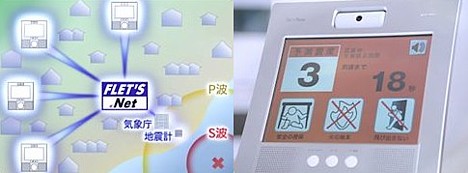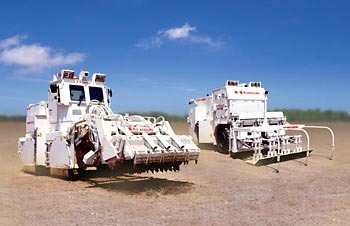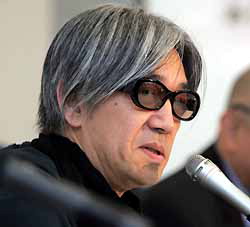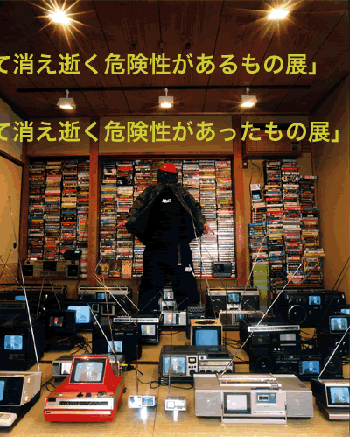This video shows a very simple, yet ingenious way to save the planet from destruction by a giant meteor.
Tag: ‘Safety’
Pre-quake alarm gives 20 seconds to duck and cover

NTT is developing a device that provides advance warning of earthquakes seconds before they strike by relying on data from a nationwide system of seismometers put in place by the Japan Meteorological Agency. The sensors detect an earthquake's primary waves ("P-waves"), which travel more quickly and are much weaker than the lower-velocity secondary waves ("S-waves") that cause the major damage associated with earthquakes.
When the sensors detect P-waves, data about the timing and strength of the coming S-waves is instantly delivered to the earthquake alarms via NTT's fiber optic network, notifying the users in their homes before the S-waves strike. The time difference between the arrival of P-waves and S-waves depends on the distance from the epicenter, so locations farther from the epicenter can receive warnings much more in advance than those near the epicenter. Unfortunately, people located directly above the epicenter, where the earthquake is at its strongest, are unlikely to receive any advance warning at all.
The TV commercial for the device (as well as the extended web version, now on YouTube) shows a mildly touching dramatization of the device at work.
The commercial focuses on a female college student who is majoring in home economics and living at home with her parents. When home alone, the girl spends most of her free time in the kitchen honing her cooking skills by preparing dishes like goya kinoko champuru, an Okinawan stir-fry made with bitter gourd, mushroom and eggs. The kitchen is equipped with an NTT earthquake alarm.
The first time the earthquake alarm sounds, the girl goes into a mild panic, squandering her 20-second warning by wondering where to set the dish she is holding. She finally crawls under the dining table and all is well.
The next time an earthquake comes, she is prepared. The alarm sounds and the mechanical voice informs her that a magnitude 3 earthquake will strike in 20 seconds. As the countdown begins, she calmly turns off the stove, opens the patio doors, and crawls under the table. The voice instructs her to protect herself from physical harm until the shaking stops, advising her not to run outside in a panic. The voice then instructs her to make sure the gas is turned off and evacuate to a safe place once the quake has passed. Finally, the voice instructs her to pay attention to the information provided by the mass media and the local authorities, again reminding her to remain calm.
Later, the girl's mother calls to check on her. Having cooked a great deal of food, the girl tells her mother to come home hungry. Later they will feast.
Luckily for all, the earthquake was only a magnitude 3 affair, unlike the monster that struck Kobe back in 1995.
I have fortunately never seen the need to duck and cover during an earthquake and I don't know how well I would fit under my dining table, but nonetheless it would be nice to have a 20-second warning before the Big One hits.
[Further reading: Asahi Shimbun (English)]
Intelligent wheelchair sees all

On September 20, Japan's National Institute of Advanced Industrial Science and Technology (AIST) unveiled an intelligent wheelchair that relies on an omnidirectional camera for a view of its surroundings, avoids collisions with people and obstacles, and knows when something is wrong with the chair's occupant. Developed with the cooperation of the National Rehabilitation Center for Persons with Disabilities, the new technology is expected to improve the safety and security of electric wheelchairs for the disabled and elderly.
While the increased prevalence of electric wheelchairs has improved the mobility of persons with serious disabilities, they have also resulted in an increased number of collisions and accidents. To boost wheelchair safety, AIST engineers incorporated elements of intelligent automotive systems, which are capable of calculating the risk of collisions before they happen and automatically applying the brakes when necessary.
The prototype wheelchair is equipped with a camera system -- interestingly dubbed Stereo Omnidirectional System (SOS) -- whose 360-degree field of vision has no blind spot. Relying on the camera images, the chair detects potential hazards that arise while in motion and decelerates or stops accordingly. The chair also checks the occupant for signs of abnormality (unusual posture) and is equipped with a function that allows the occupant to control the chair by gesturing (pointing). Check out the AIST press release for videos of the chair in action.
The wheelchair is currently equipped with a function for transmitting the camera's color video via wireless LAN, and AIST is investigating the possibility of enabling the video to be delivered via cellular phone and providing support for remote-control functions. AIST will soon subject the prototype to rigorous testing and continue upgrading the functions.
This intelligent wheelchair technology will be demonstrated at the 2006 Home Care and Rehabilitation Exhibition scheduled for September 27 to 29 in Tokyo.
[Sources: MYCOM Journal and AIST press release]
Intelligent road system to boost traffic safety

Japan's National Police Agency is moving forward with plans to introduce a road safety system that alerts drivers to potential hazards through audio and visual notifications on in-vehicle navigation systems. With testing scheduled to begin in Tokyo this year, the system is expected to be rolled out in 2008 after the test results are verified.
The system, developed by the Universal Traffic Management Society of Japan (UTMS), is known as the Driving Safety Support System (DSSS). The system relies on networks of two-way communication devices called infrared beacons installed at a height of 5.5 meters above roadways, particularly in accident-prone areas. These infrared beacons detect the presence of vehicles and pedestrians in hard-to-see locations and communicate this information to drivers through their in-vehicle navigation systems.
As many as 20 different subsystems, each designed to prevent a specific type of accident (rear-end collisions, head-on collisions, right-turn collisions, etc.), are being studied. Of these subsystems, 5 are expected to be rolled out in 2008 and are being tested in Tokyo -- including one that alerts drivers to the presence of pedestrians when turning left through intersections, one for highways that provides information about merging traffic, and one that provides information about traffic snarl-ups to prevent rear-end collisions.
DSSS is similar to the Vehicle Information and Communication System (VICS), an existing system that also relies on infrared beacons to communicate traffic information to in-vehicle navigation systems, but only about 10% of all vehicles in Tokyo make use of this system. Future studies will focus on developing ways to popularize this type of system.
The tests in Tokyo are designed to provide a detailed investigation of the effectiveness and impact on the safety of ordinary drivers. When experimental testing of the 5 systems was carried out in Toyota City in Aichi prefecture from 2002 to 2004, more than 80% of users thought they were effective.
[Source: Corism]
Kawasaki BULLDOG to sweep Cambodian landmines
 On June 21, Kawasaki Heavy Industries announced plans to send its BULLDOG landmine clearing system to Cambodia, where it will be put to the test in the field. The BULLDOG system, which employs Kawasaki's robotic remote control and electronic control technology, has undergone some upgrades after conducting mine clearing operations in Afghanistan in 2004 and 2005.
On June 21, Kawasaki Heavy Industries announced plans to send its BULLDOG landmine clearing system to Cambodia, where it will be put to the test in the field. The BULLDOG system, which employs Kawasaki's robotic remote control and electronic control technology, has undergone some upgrades after conducting mine clearing operations in Afghanistan in 2004 and 2005.
By conducting test operations in Cambodian minefields, Kawasaki hopes to gather data that will help them develop a BULLDOG system well-suited to the local vegetation, soil conditions, and terrain. As was the case in Afghanistan, the operations are financed by a grant extended by the Japanese government.
The BULLDOG system consists of three parts: (1) the MINE DOG, a mine-detecting vehicle equipped with mine detection sensors and a variety of cameras, (2) the MINE BULL, a mine-clearing vehicle equipped with a drum that drills the earth to excavate and detonate mines and a mechanism to collect waste products, and (3) a system of devices for remote control and operation.
Relying on an 8-channel system of mine detection sensors that automatically adjust their height with respect to uneven terrain, the MINE DOG can detect anti-personnel mines and unexploded bombs underground. A camera mounted on top of the vehicle detects trip wires and mines scattered on the ground surface. Sensor data is analyzed using software developed by Kawasaki, which allows operators to distinguish mines from objects such as rocks or cavities in the soil. For the tests in Cambodia, Kawasaki added features to help the MINE DOG deal with vegetation, as well as features to improve mobility on soft ground.
The MINE BULL detonates anti-personnel mines by means of a high-speed digging drum that turns the soil in front of the vehicle. The vehicle's excavation depth monitor, GPS antenna, and route-monitoring cameras ensure steady digging and forward motion, and a system of magnets extract waste materials that typically slow down the safety inspections that follow mine clearing operations. To deal with Cambodia's sticky soil, Kawasaki added a system of brushes to prevent soil buildup and mobility-enhancing features similar to those added to the MINE DOG.
The MINE BULL will be shipped to Cambodia in June, and work will begin in a minefield near Siem Reap in July. The MINE DOG will be shipped in August, and it will go to work beginning in October.
Kawasaki aims to use the data obtained from these tests to quickly develop a BULLDOG system well-suited for the Cambodian landscape, which they hope will make a valuable contribution to international demining activities that involve the Japanese government and international NGOs.
[Source: ZDNet Japan]
Ryuichi Sakamoto expands attack on controversial law
 At a press conference held in Tokyo on March 23, composer Ryuichi Sakamoto made a public appeal to the government to exempt all secondhand electrical goods from the Electrical Appliance and Material Safety Law (a.k.a. PSE Law, or DENAN). The law, which is set to take effect April 1, will prohibit businesses from selling electrical goods that do not bear the PSE mark (that signifies compliance with the law?s safety standards). In other words, before putting products up for sale, dealers will be forced to file paperwork and perform tests (such as 1,000 volts for one minute) on each and every pre-2002 electrical product in order to obtain a PSE mark. Though the government recently revised the law so that it does not apply to certain "vintage" electric instruments with high scarcity value, Sakamoto called upon the government to expand the exemption to all secondhand electrical goods.
At a press conference held in Tokyo on March 23, composer Ryuichi Sakamoto made a public appeal to the government to exempt all secondhand electrical goods from the Electrical Appliance and Material Safety Law (a.k.a. PSE Law, or DENAN). The law, which is set to take effect April 1, will prohibit businesses from selling electrical goods that do not bear the PSE mark (that signifies compliance with the law?s safety standards). In other words, before putting products up for sale, dealers will be forced to file paperwork and perform tests (such as 1,000 volts for one minute) on each and every pre-2002 electrical product in order to obtain a PSE mark. Though the government recently revised the law so that it does not apply to certain "vintage" electric instruments with high scarcity value, Sakamoto called upon the government to expand the exemption to all secondhand electrical goods.
?It is not up to the bureaucrats to determine what is ?vintage? and what is not," said Sakamoto, who was joined at the press conference by several other musicians, including composer/performer Hideki Togi and producer Kenzo Saeki. "The things we use should not be a matter for the government bureaucracy to decide. They think that we musicians will shut up because vintage instruments are no longer subject to the law, but I?d like to see everyone get behind those who make a living in the recycled goods business.?
Sakamoto was scheduled to deliver a formal written demand, in the form of a petition, to the Minister of Economy, Trade, and Industry after the press conference. The petition includes the signatures of about 50 musicians, including Tetsuya Komuro and Misayoshi Yamazaki, as well as 8 music organizations.
[Sources: Mainichi Shimbun, Kyodo]
Things in danger of vanishing…

Nanzuka Underground (Shibuya, Tokyo) has put together an exhibit entitled "Things That Are In Danger Of Vanishing Because Of [the] Electric Appliance And Materials Law." The law, which is set to take effect on April 1, has been widely criticized for its expected impact on the secondhand electronics industry, particularly with respect to musical equipment. Though METI appears to have done some backpedaling to ease the restrictions on certain "vintage" electronics, the concerns remain.
Organized to raise consumer awareness about "the crisis we are facing now," the exhibit features a display of products provided by TURBO SONIC (a secondhand electronics store specializing in products from the 70s and 80s), as well as art work made from numerous parts that belong to the store.
From the press release: "If there is anyone who feels even slightly uncomfortable about the law, we want you to visit the exhibition and hear your voice."
The exhibit runs from March 24 to April 9. Admission is free.
Read the in-depth Nanzuka Underground press release (English/Japanese) for more information.
